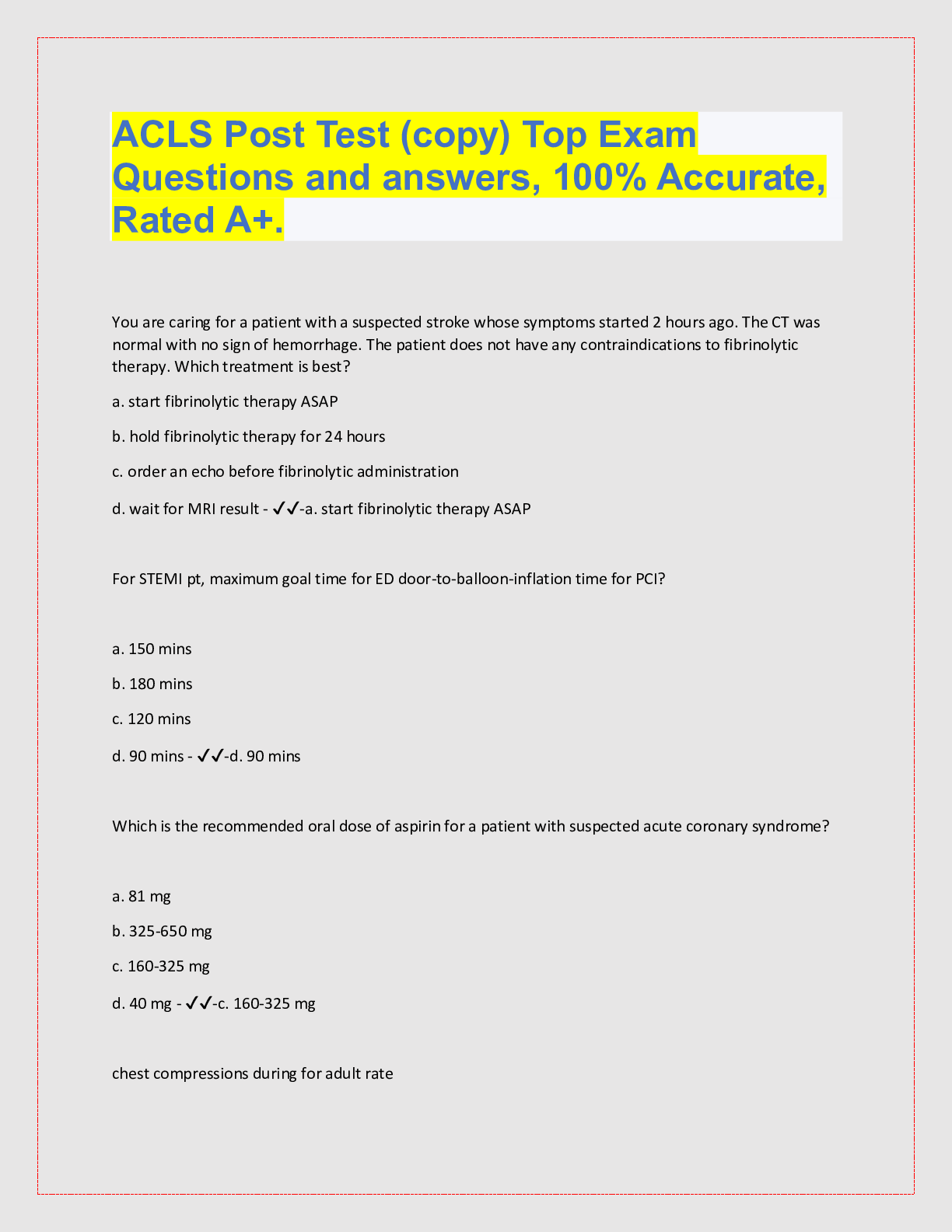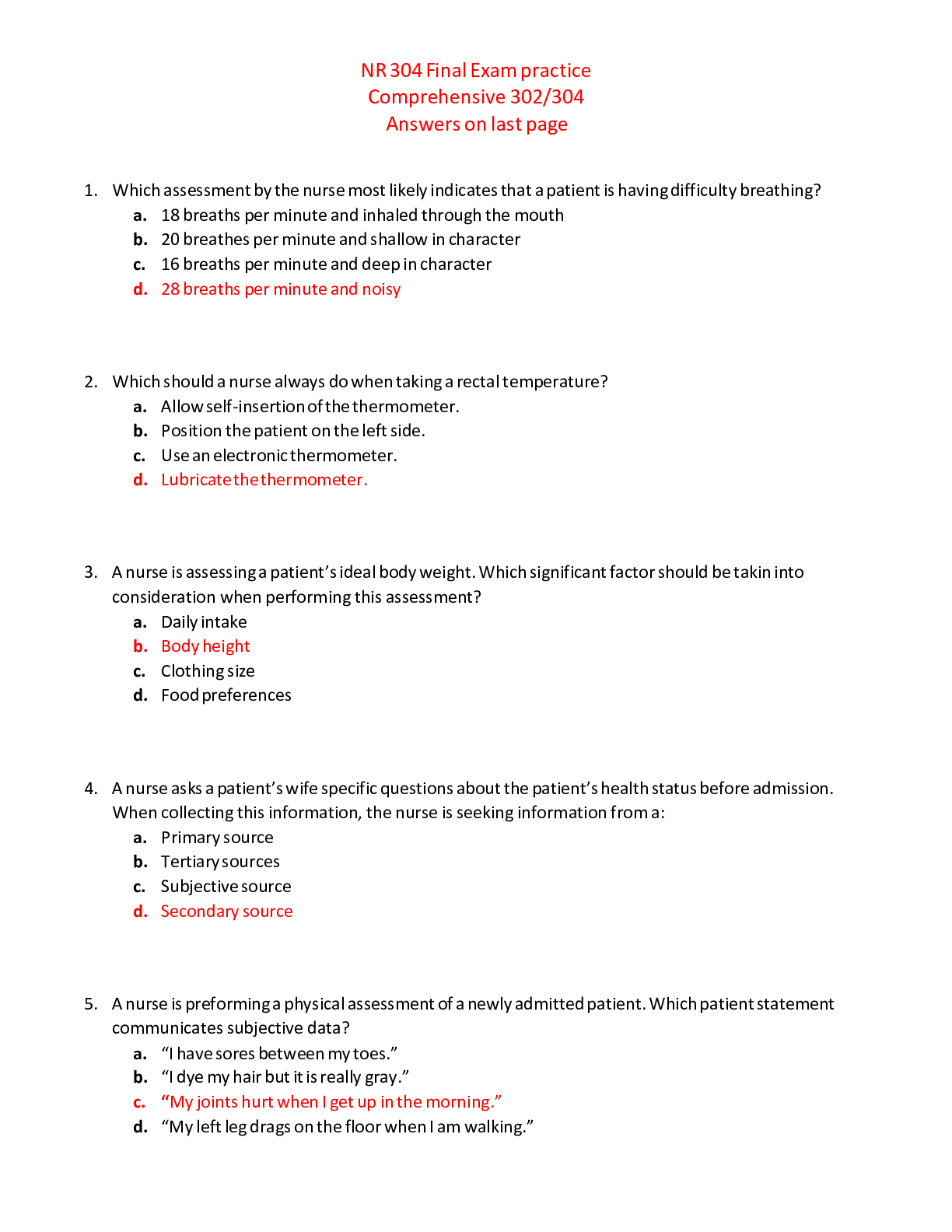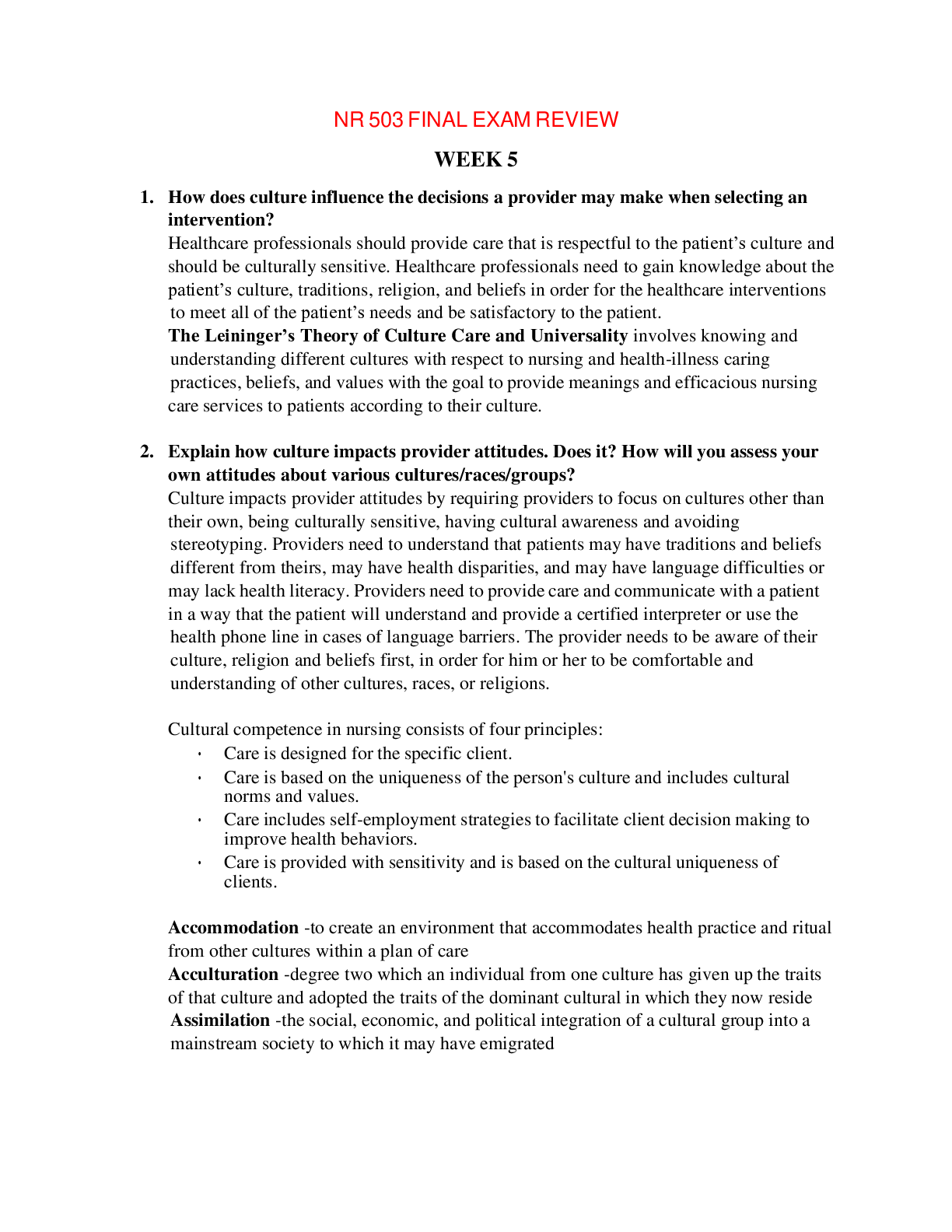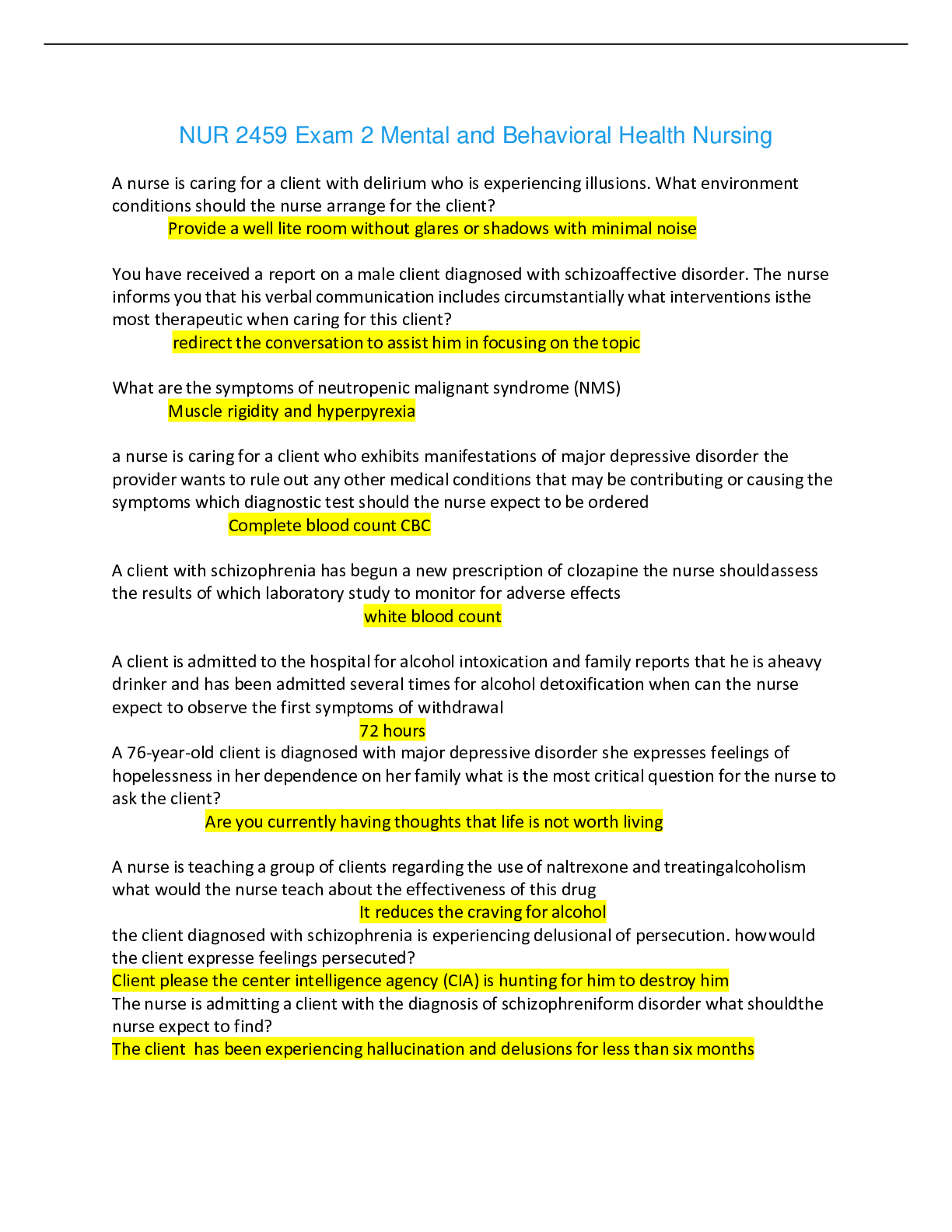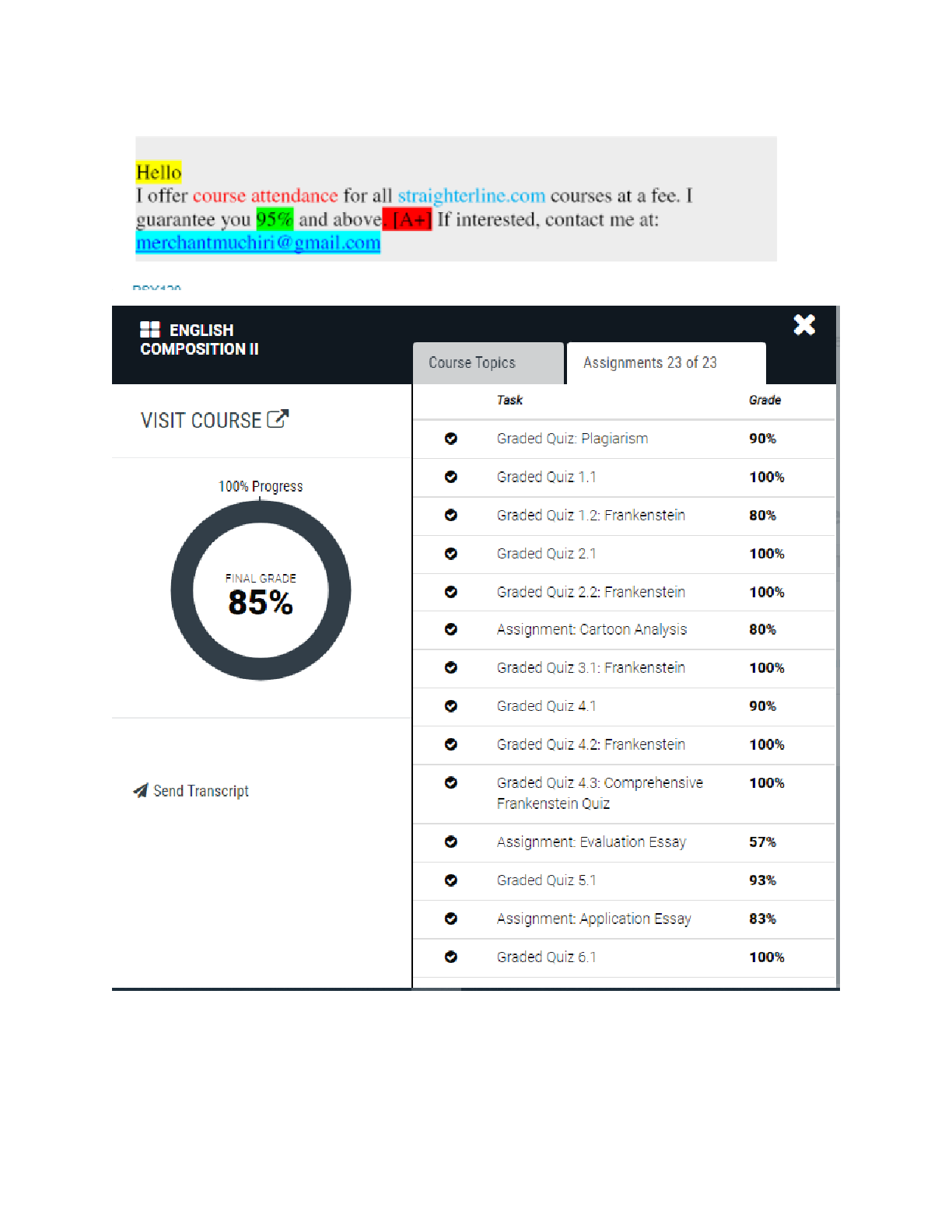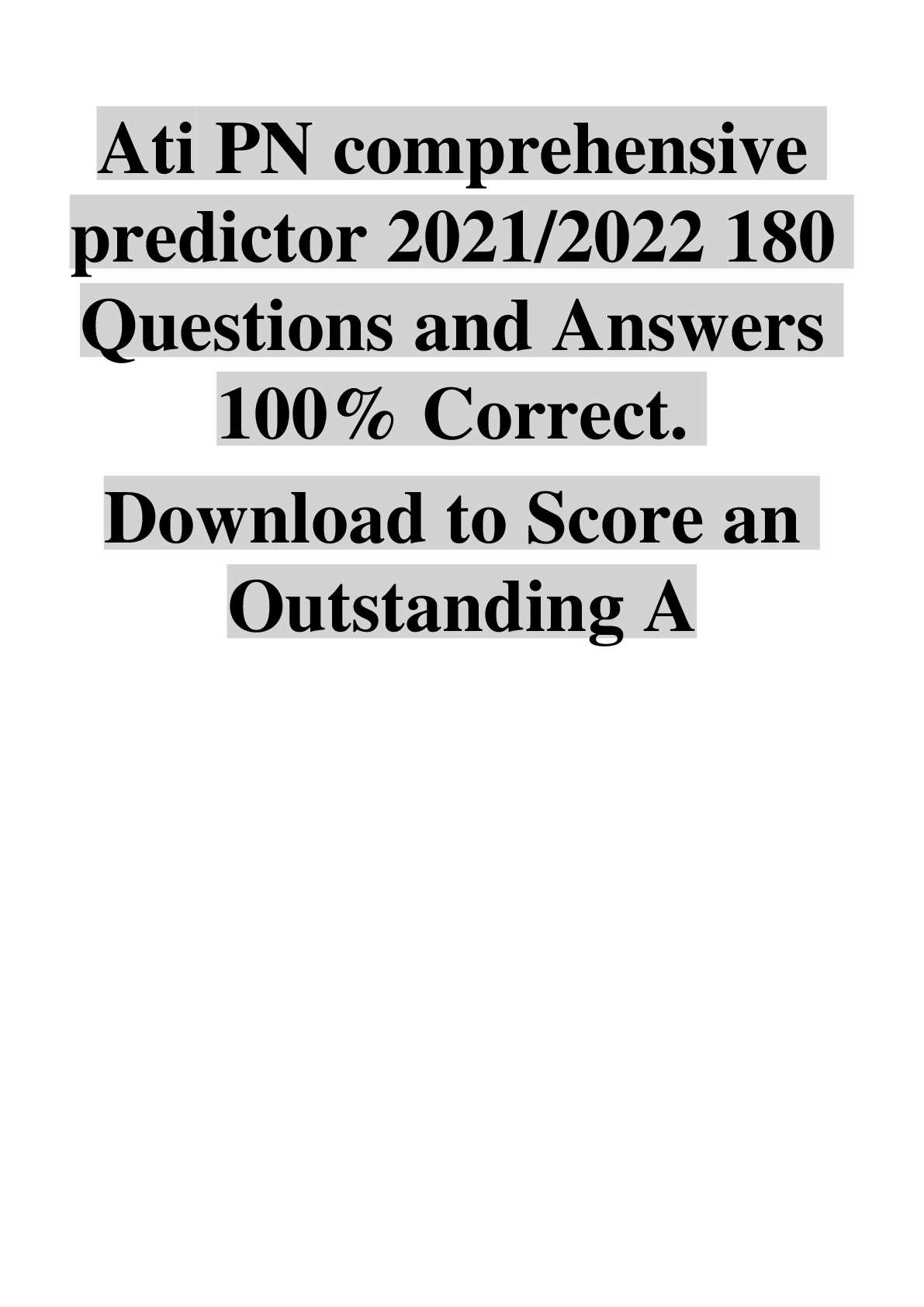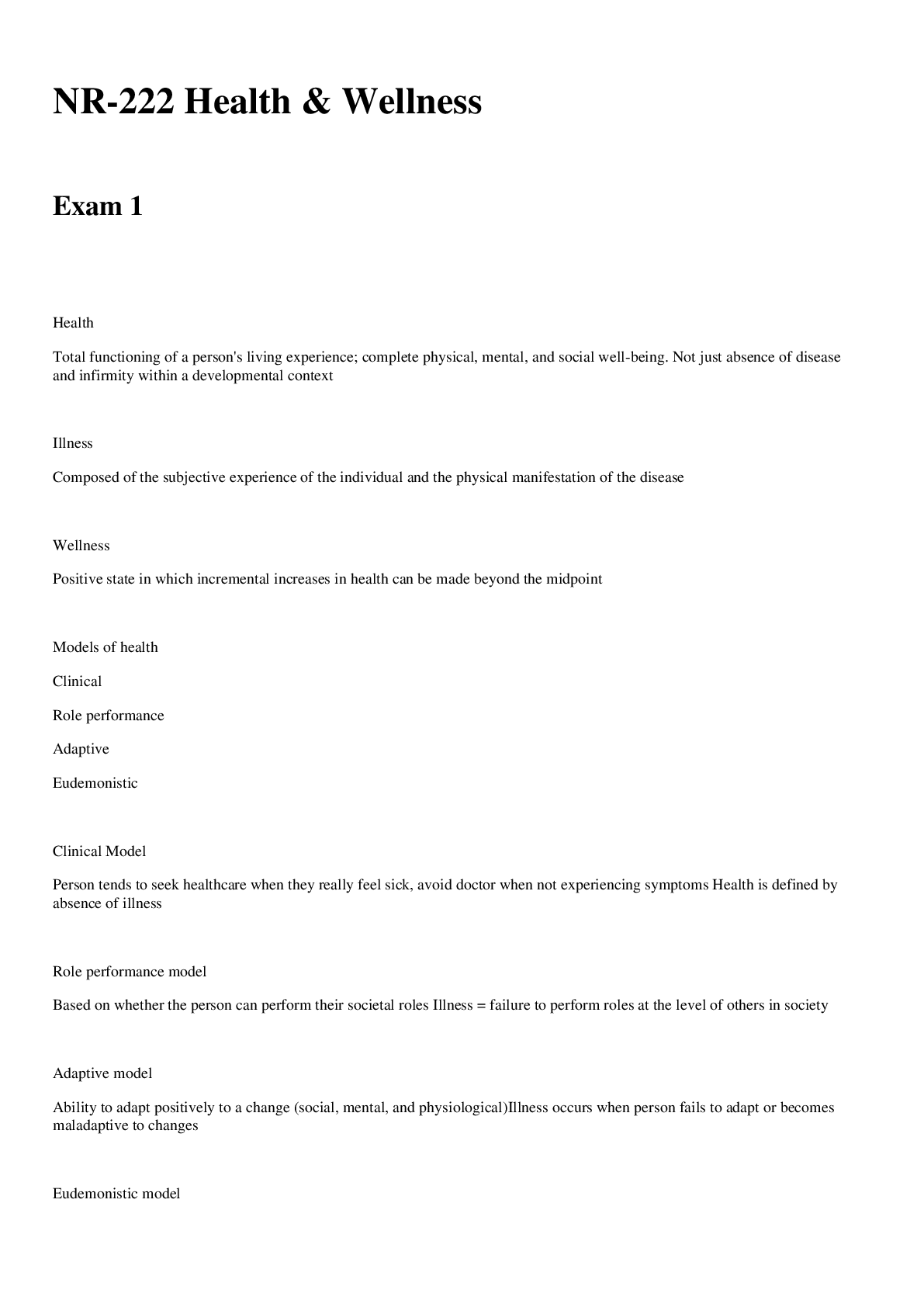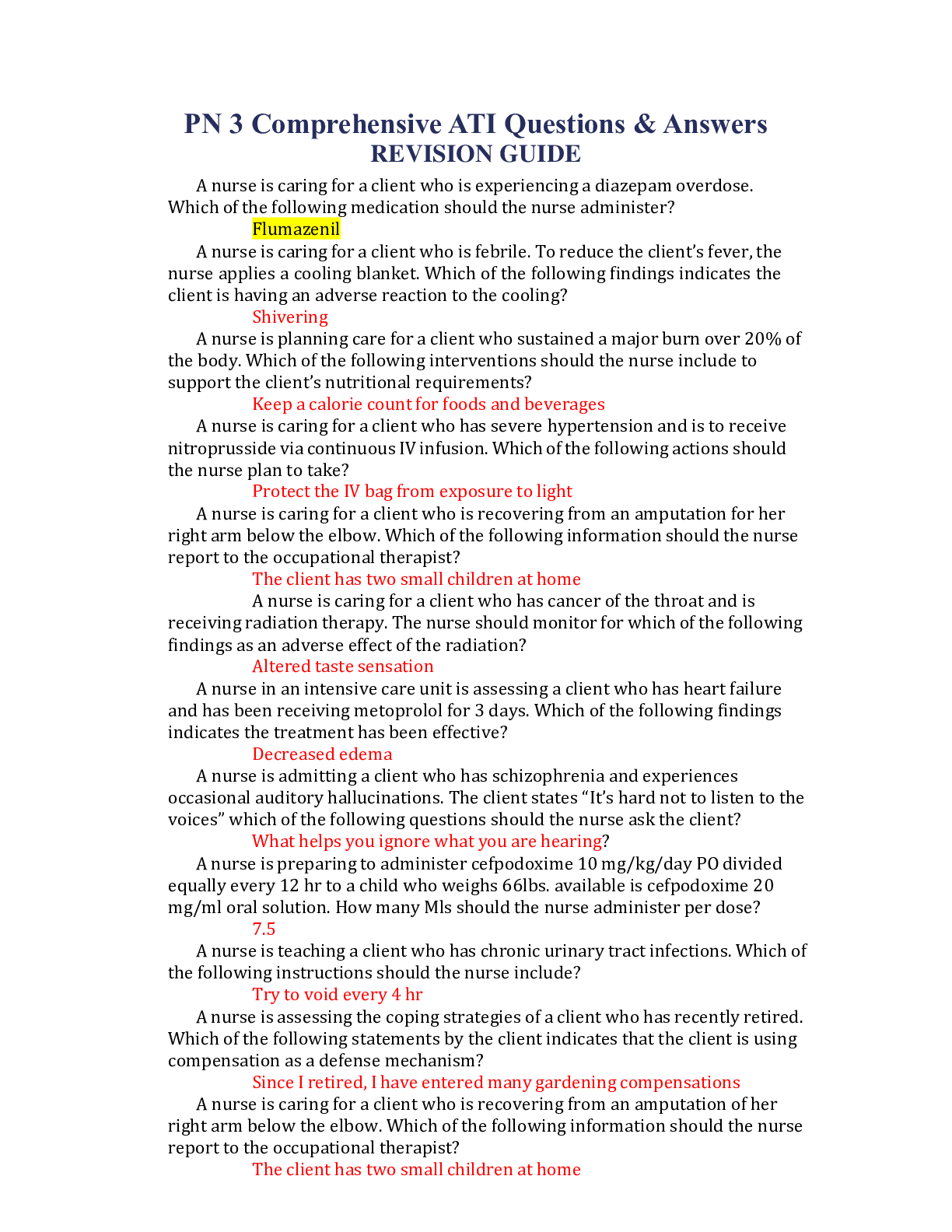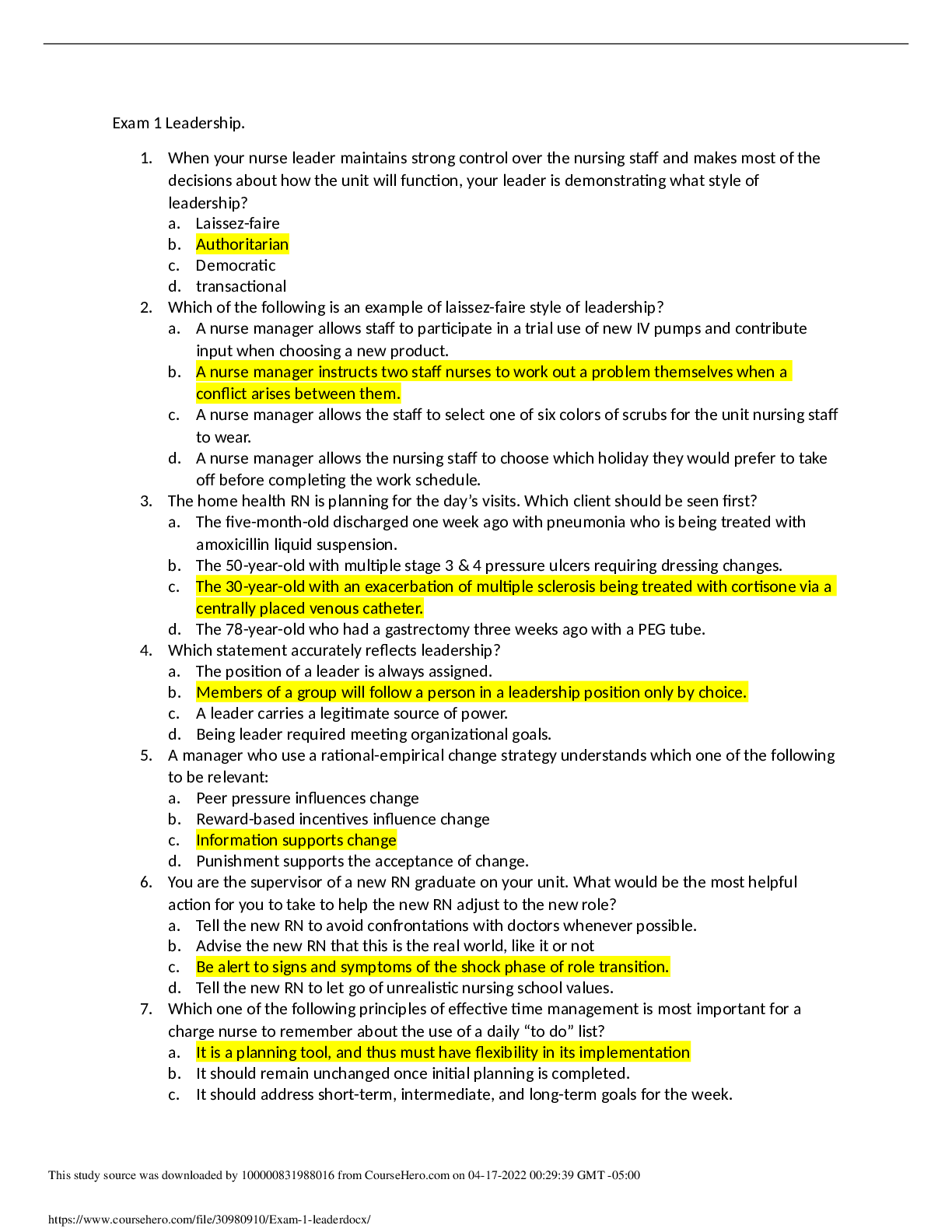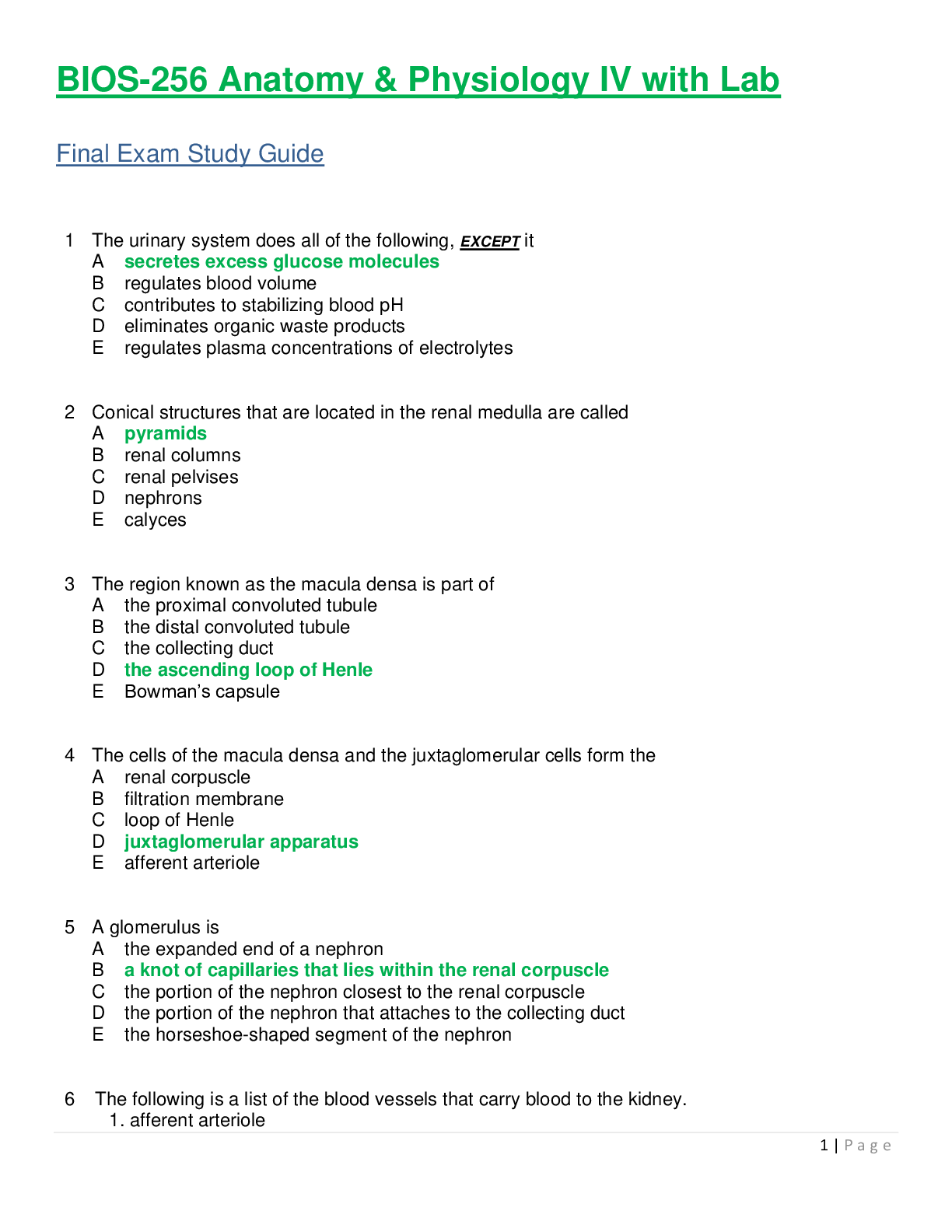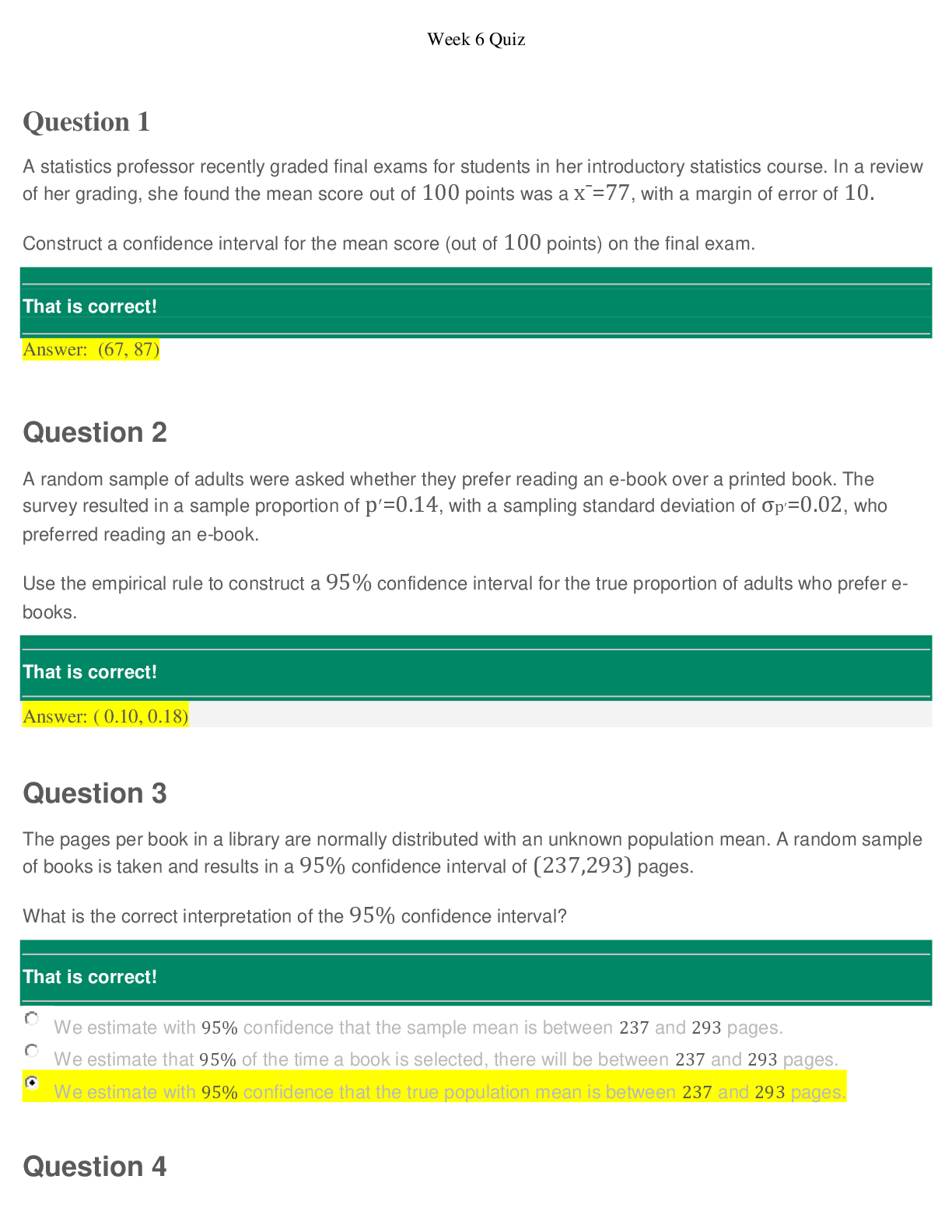*NURSING > EXAM > NR 507 Midterm Exam (Version-3) / NR507 Midterm Exam (60 Q & A, Latest-2021): Advanced Pathophysiolo (All)
NR 507 Midterm Exam (Version-3) / NR507 Midterm Exam (60 Q & A, Latest-2021): Advanced Pathophysiology: Chamberlain College of Nursing |100% Correct Answers, Download to Score A|
Document Content and Description Below
NR 507 Midterm Exam (Version-3) / NR507 Midterm Exam (60 Q & A, Latest-2021): Advanced Pathophysiology: Chamberlain College of Nursing |100% Correct Answers, Download to Score A| NR507 Week 4 Midterm... Exam / NR 507 Week 4 Midterm Exam (Latest): Advanced Pathophysiology: Chamberlain College of Nursing Chamberlain NR 507 Midterm Exam / Chamberlain NR507 Midterm Exam (Latest): Advanced Pathophysiology 1. Question : What is the final stage of the infectious process? Colonization Invasion Multiplication Spread Question 2. Question : Where in the respiratory tract do the majority of foreign objects aspirated by children finally lodge? Trachea Left lung Bronchus Bronchioles Question 3. Question : What is the primary cause of respiratory distress syndrome (RDS) of the newborn? Immature immune system Small alveoli Surfactant deficiency Anemia Question 4. Question : Which statement concerning benign tumors is true? The resulting pain is severe. Benign tumors are not encapsulated. Benign tumors are fast growing. The cells are well-differentiated. Question 5. Question : Which compensatory mechanism is spontaneously used by children diagnosed with tetralogy of Fallot to relieve hypoxic spells? Lying on their left side Performing the Valsalva maneuver Squatting Hyperventilating Question 6. Question : Which cytokines initiate the production of corticotropin-releasing hormone (CRH)? IL–1 and IL-6 IL-2 and TNF- IFN and IL-12 TNF-ß and IL-4 Question 7. Question : Hemolytic disease of the newborn (HDN) can occur if the mother: Is Rh-positive and the fetus is Rh-negative Is Rh-negative and the fetus is Rh-positive Has type A blood and the fetus has type O Has type AB blood and the fetus has type B Question 8. Question : Decreased lung compliance means that the lungs are demonstrating which characteristic? Difficult deflation Easy inflation Stiffness Inability to diffuse oxygen Question 9. Question : Which statement concerning exotoxins is true? Exotoxins are contained in cell walls of gram-negative bacteria. Exotoxins are released during the lysis of bacteria. Exotoxins are able to initiate the complement and coagulation cascades. Exotoxins are released during bacterial growth. Question 10. Question : What is the ratio of coronary capillaries to cardiac muscle cells? 1:1 (one capillary per one muscle cell) 1:2 (one capillary per two muscle cells) 1:4 (one capillary per four muscle cells) 1:10 (one capillary per ten muscle cells) Question 11. Question : How high does the plasma glucose have to be before the threshold for glucose is achieved? 126 mgdl 150 mgdl 180 mgdl 200 mgdl Question 12. Question : What is the chief predisposing factor for respiratory distress syndrome (RDS) of the newborn? Low birth weight Alcohol consumption during pregnancy Premature birth Smoking during pregnancy Question 13. Question : Perceived stress elicits an emotional, anticipatory response that begins where? Prefrontal cortex Anterior pituitary Limbic system Hypothalamus Question 14. Question : Causes of hyperkalemia include: Hyperparathyroidism and malnutrition Vomiting and diarrhea Renal failure and Addison disease Hyperaldosteronism and Cushing disease Question 15. Question : Between which months of age does sudden infant death syndrome (SIDS) most often occur? 0 and 1 2 and 4 5 and 6 6 and 7 Question 16. Question : What is the fundamental physiologic manifestation of anemia? Hypotension Hyperesthesia Hypoxia Ischemia Question 17. Question : What is the life span of platelets (in days)? 10 30 90 120 Question 18. Question : What part of the kidney controls renal blood flow, glomerular filtration, and renin secretion? Macula densa Visceral epithelium Juxtaglomerular apparatus (JGA) Filtration slits Question 19. Question : An infant has a loud, harsh, holosystolic murmur and systolic thrill that can be detected at the left lower sternal border that radiates to the neck. These clinical findings are consistent with which congenital heart defect? Atrial septal defect (ASD) Ventricular septal defect (VSD) Patent ductus arteriosus (PDA) Atrioventricular canal (AVC) defect Question 20. Question : The coronary ostia are located in the: Left ventricle Aortic valve Coronary sinus Aorta Question 21. Question : The only surface inside the nephron where cells are covered with microvilli to increase the reabsorptive surface area is called the: Proximal convoluted tubules Distal tubules Ascending loop of Henle Descending loop of Henle Question 22. Question : The drug heparin acts in hemostasis by which processes? Inhibiting thrombin and antithrombin III (AT-III) Preventing the conversion of prothrombin to thrombin Shortening the fibrin strands to retract the blood clot Degrading the fibrin within blood clots Question 23. Question : Which immunoglobulin (Ig) is present in childhood asthma? IgM IgG IgE IgA Question 24. Question : Immunoglobulin E (IgE) is associated with which type of hypersensitivity reaction? I II III IV Question 25. Question : Which organ is stimulated during the alarm phase of the general adaptation syndrome (GAS)? Adrenal cortex Hypothalamus Anterior pituitary Limbic system Question 26. Question : Which congenital heart defects occur in trisomy 13, trisomy 18, and Down syndrome? Coarctation of the aorta (COA) and pulmonary stenosis (PS) Tetralogy of Fallot and persistent truncus arteriosus Atrial septal defect (ASD) and dextrocardia Ventricular septal defect (VSD) and patent ductus arteriosus (PDA) Question 27. Question : What substance stimulates renal hydroxylation in the process of producing vitamin D? Erythropoietin Thyroid hormone Calcitonin Parathyroid hormone Question 28. Question : Which term is used to identify the movement of gas and air into and out of the lungs? Perfusion Ventilation Respiration Diffusion Question 29. Question : Where are antibodies produced? Helper T lymphocytes Thymus gland Plasma cells Bone marrow Question 30. Question : What is the most common cause of insufficient erythropoiesis in children? Folic acid deficiency Iron deficiency Hemoglobin abnormality Erythrocyte abnormality Question 31. Question : In a normal, nonmutant state, an oncogene is referred to as a: Basal cell Target cell Caretaker gene Proto-oncogene Question 32. Question : Which manifestations of vasoocclusive crisis are associated with sickle cell disease (SCD) in infants? Atelectasis and pneumonia Edema of the hands and feet Stasis ulcers of the hands, ankles, and feet Splenomegaly and hepatomegaly Question 33. Question : What is the life span of an erythrocyte (in days)? 20 to 30 60 to 90 100 to 120 200 to 240 Question 34. Question : Which term is used to describe a muscle cell showing a reduced ability to form new muscle while appearing highly disorganized? Dysplasia Hyperplasia Myoplasia Anaplasia Question 35. Question : Which hepatitis virus is known to be sexually transmitted? A B C D Question 36. Question : What is the primary problem resulting from respiratory distress syndrome (RDS) of the newborn? Consolidation Pulmonary edema Atelectasis Bronchiolar plugging Question 37. Question : What is the action of urodilatin? Urodilatin causes vasoconstriction of afferent arterioles. It causes vasodilation of the efferent arterioles. Urodilatin inhibits antidiuretic hormone secretion. It inhibits salt and water reabsorption. Question 38. Question : Erythrocyte life span of less than 120 days, ineffective bone marrow response to erythropoietin, and altered iron metabolism describe the pathophysiologic characteristics of which type of anemia? Aplastic Sideroblastic Anemia of chronic disease Iron deficiency Question 39. Question : The function of the foramen ovale in a fetus allows what to occur? Right-to-left blood shunting Left-to-right blood shunting Blood flow from the umbilical cord Blood flow to the lungs Question 40. Question : What is the most abundant class of plasma protein? Globulin Albumin Clotting factors Complement proteins Question 41. Question : When a patient has small, vesicular lesions that last between 10 and 20 days, which sexually transmitted infection is suspected? Genital herpes Chancroid Syphilis Chlamydia Question 42. Question : During an IgE-mediated hypersensitivity reaction, which leukocyte is activated? Neutrophils Monocytes Eosinophils T lymphocytes Question 43. Question : What effect do natriuretic peptides have during heart failure when the heart dilates? Stimulates antidiuretic hormones. Inhibits antidiuretic hormones. Stimulates renin and aldosterone. Inhibits renin and aldosterone. Question 44. Question : Blood vessels of the kidneys are innervated by the: Vagus nerve Sympathetic nervous system Somatic nervous system Parasympathetic nervous system Question 45. Question : What is the first stage in the infectious process? Invasion Colonization Spread Multiplication Question 46. Question : Which drug may be prescribed orally for outbreak management of herpes simplex viral (HSV) infections? Acyclovir (Zovirax) 5-Fluorouracil (5-FU) Zidovudine (AZT) (Retrovir) Bichloroacetic acid (BCA) Question 47. Question : What is the most common cause of iron deficiency anemia (IDA)? Decreased dietary intake Chronic blood loss Vitamin deficiency Autoimmune disease Question 48. Question : Causes of hyperkalemia include: Hyperparathyroidism and malnutrition Vomiting and diarrhea Renal failure and Addison disease Hyperaldosteronism and Cushing disease Question 49. Question : A person with type O blood is considered to be the universal blood donor because type O blood contains which of the following? No antigens No antibodies Both A and B antigens Both A and B antibodies Question 50. Question : Which type of antibody is involved in type I hypersensitivity reaction? IgA IgE IgG IgM Question 51. Question : Which cardiac chamber has the thinnest wall and why? The right and left atria; they are low-pressure chambers that serve as storage units and conduits for blood. The right and left atria; they are not directly involved in the preload, contractility, or afterload of the heart. The left ventricle; the mean pressure of blood coming into this ventricle is from the lung, which has a low pressure. The right ventricle; it pumps blood into the pulmonary capillaries, which have a lower pressure compared with the systemic circulation. Question 52. Question : Which criterion is used to confirm a diagnosis of asthma in an 8-year-old child? Parental history of asthma Serum testing that confirms increased immunoglobulin E (IgE) and eosinophil levels Reduced expiratory flow rates confirmed by spirometry testing Improvement on a trial of asthma medication Question 53. Question : The lung is innervated by the parasympathetic nervous system via which nerve? Vagus Phrenic Brachial Pectoral Question 54. Question : The generation of clonal diversity occurs primarily during which phase of life? Fetal Neonatal Infancy Puberty Question 55. Question : What is the role of collagen in the clotting process? Initiates the clotting cascade. Activates platelets. Stimulates fibrin. Deactivates fibrinogen. Question 56. Question : What physical sign is the result of turbulent blood flow through a vessel? Increased blood pressure during periods of stress Bounding pulse felt on palpation Cyanosis observed on excretion Murmur heard on auscultation Question 57. Question : The most common site of metastasis for a patient diagnosed with prostate cancer is which location? Bones Brain Bladder Kidney Question 58. Question : What is the direct action of atrial natriuretic hormone? Sodium retention Sodium excretion Water retention Water excretion Question 59. Question : Continuous increases in left ventricular filing pressures result in which disorder? Mitral regurgitation Mitral stenosis Pulmonary edema Jugular vein distention Question 60. Question : Phagocytosis involves neutrophils actively attacking, engulfing, and destroying which microorganisms? Bacteria Fungi Viruses Yeasts [Show More]
Last updated: 1 year ago
Preview 1 out of 26 pages
Reviews( 0 )
Document information
Connected school, study & course
About the document
Uploaded On
Dec 27, 2020
Number of pages
26
Written in
Additional information
This document has been written for:
Uploaded
Dec 27, 2020
Downloads
0
Views
87



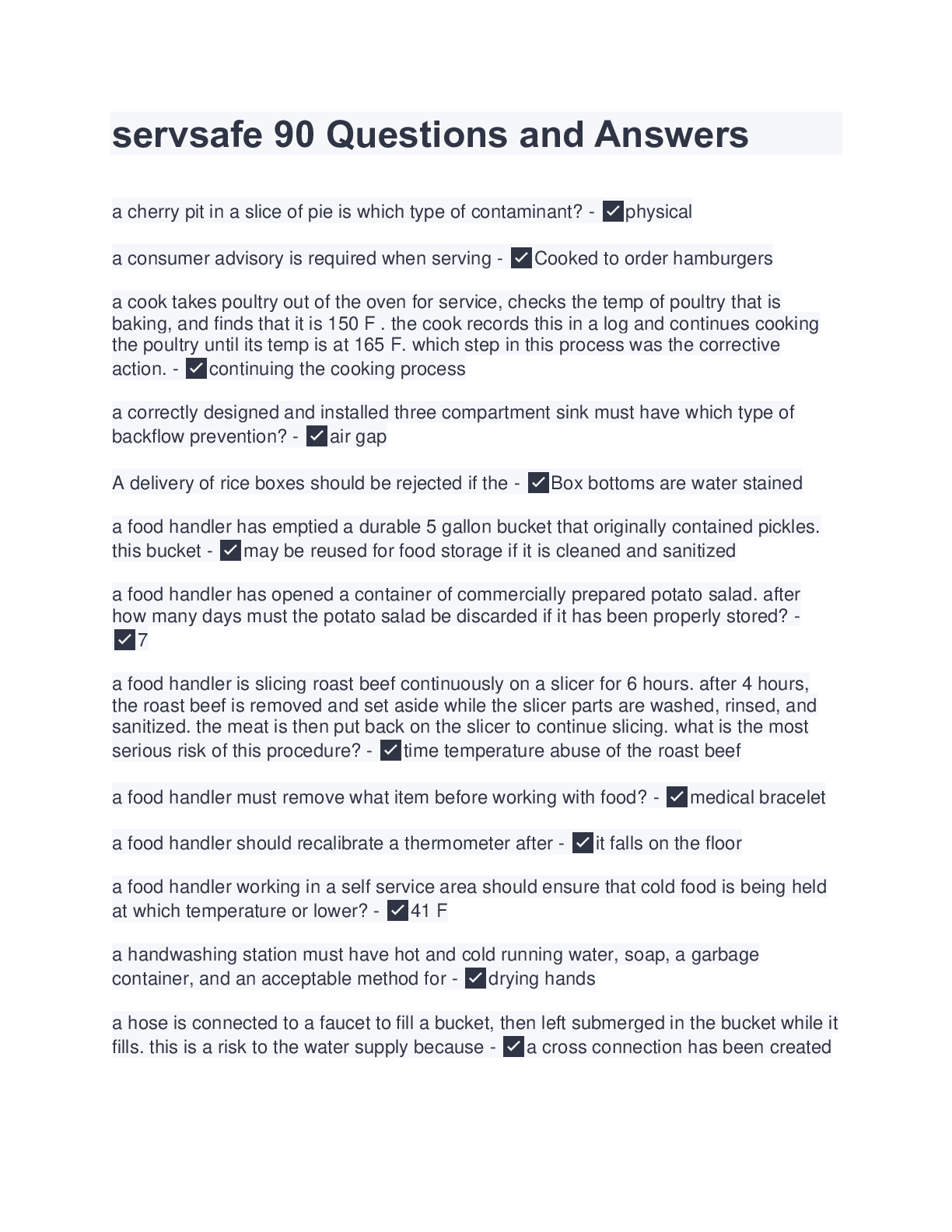
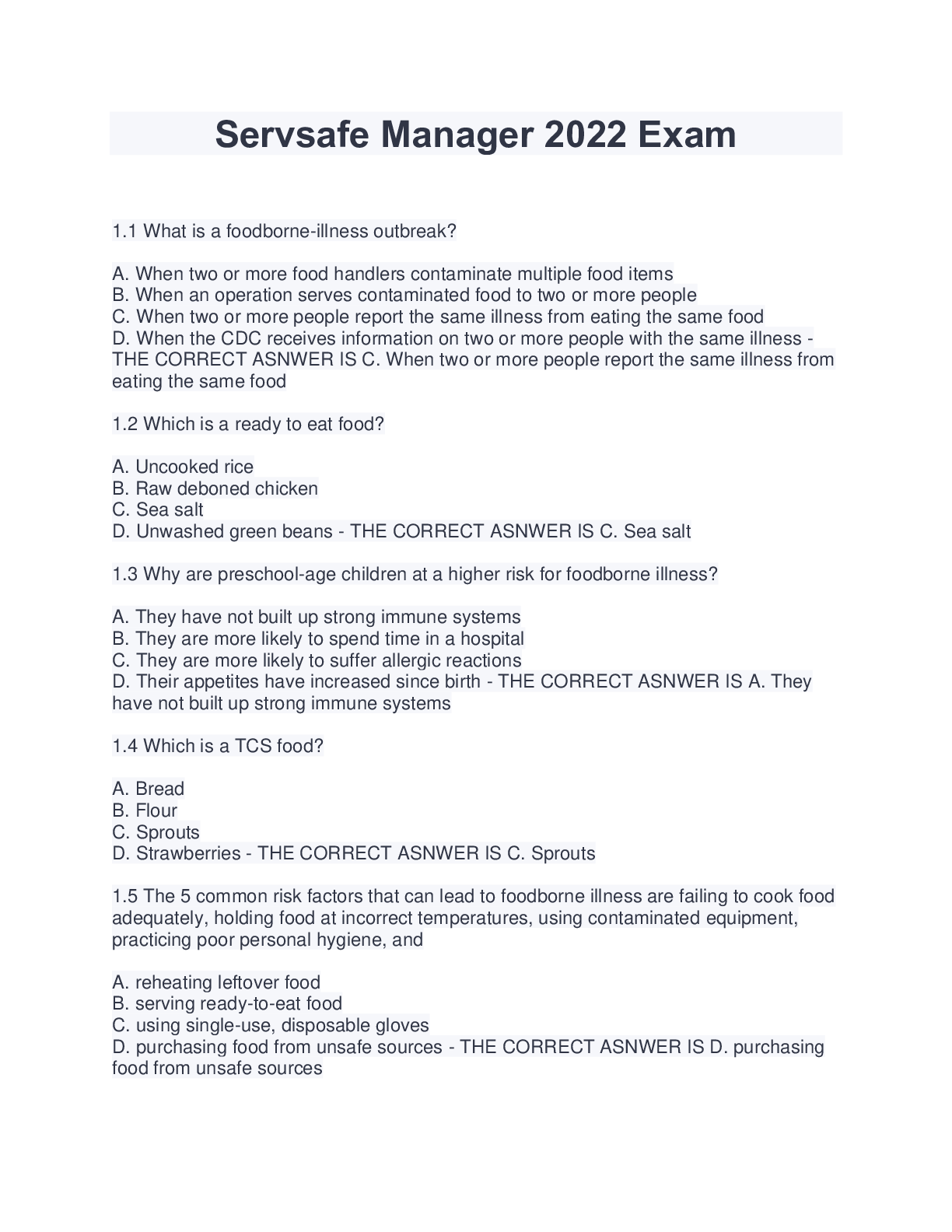

.png)


